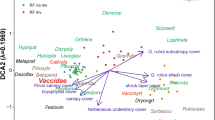Abstract
In northern Thailand, a growing interest in restoring forests for wildlife conservation and environmental protection is increasing demand for high quality planting stock of a wide range of native forest tree species. Since most native tree species have never been grown in nurseries, their production is hindered by a lack of knowledge of basic propagation methods. Basic data on germination and performance of ten indigenous ‘framework’ tree species, Castanopsis acuminatissima, Dalbergia rimosa, Diospyros glandulosa, Eugenia albiflora, Ficus glaberrima var. glaberrima, Lithocarpus craibianus, Melia toosendan, Prunus cerasoides, Quercus semiserrata and Spondias axillaris were collected during the production process. Different species produce seeds at different times of the year and they have different growth rates, yet saplings must attain a plantable size by the optimum planting time i.e. the start of the wet season. Germination percentages ranged from 38 to 89%, and the time in the nursery to reach a plantable size ranged from 119 days for Prunus cerasoides, when it had reached a mean height of 48.6 cm (SD 7.9), to 609 days for Lithocarpus craibianus, when it had reached mean height of 40.5 cm (SD 10.6). This paper discusses the scheduling of production for these candidate framework species.
Similar content being viewed by others
References
Blakesley D., Anusarnsunthorn V., Kerby J., Navakitbumrung P., Kuarak C., Zangkum S. et al. 2000. Nursery technology and tree species selection for restoring forest biodiversity in northern Thailand. In: Elliott S., Kerby J., Blakesley D., Hardwick K.,Woods K. and Anusarnsunthorn V. (eds), Forest Restoration for Wildlife Conservation. Chiang Mai University, pp. 207-222.
Chatwiroon P. 1997. Forest situation and some responses in Thailand. Paper presented at the workshop 'From Reforestation to Rehabilitation'. Kuranda, Queensland, Australia.
Forest Restoration Research Unit 1998. Forests for the Future: Growing and Planting Native Trees for Restoring Forest Ecosystems. In: Elliott S., Anusarnsunthorn V. and Blakesley D. (eds), pp 60.
Goosem S. and Tucker N. 1995. Repairing the Rainforest. Cassowary Publications, Cairns, Australia.
Lamb D., Parrotta J., Keenan R. and Tucker N. 1997. Rejoining habitat fragments: restoring degraded forest lands. In: Laurance W.F. and Bierregaard R.O. (eds), Tropical Forest Remnants: Ecology, Management and Conservation of Fragmented Communities. University of Chicago Press, pp. 366-385.
Tucker N. and Murphy T. 1997. The effects of ecological rehabilitation on vegetation recruitment: some observations from the Wet Tropics of North Queensland. Forest Ecol. Manage. 99: 133–152.
Author information
Authors and Affiliations
Rights and permissions
About this article
Cite this article
Elliott, S., Kuarak, C., Navakitbumrung, P. et al. Propagating framework trees to restore seasonally dry tropical forest in northern Thailand. New Forests 23, 63–70 (2002). https://doi.org/10.1023/A:1015641119271
Issue Date:
DOI: https://doi.org/10.1023/A:1015641119271




